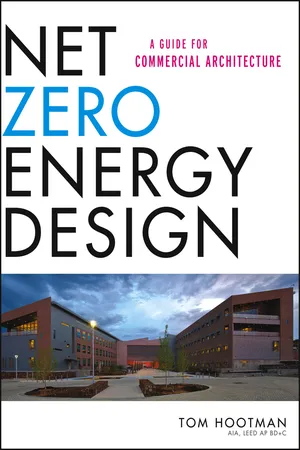![]()
Chapter 1
Net Zero Energy Building Overview
The Case for Net Zero Energy Buildings
A Global Solution
The twenty-first century is shaping up to be a transitional era for the way humanity dwells on this earth. The pressure we are placing on the planet’s resources has become increasingly unsustainable. The resulting problems we face, such as water and resource scarcity, increasing energy demands and costs, shrinking fossil fuel reserves, and a changing climate, have sounded a wakeup call heard round the world. Those who are heeding the call and embracing the need for change are finding in the necessary solutions opportunities not only to address this global set of problems but to advance and improve humanity’s relationship with the living world, and improve our quality of life.
Much of the stress we impose on the earth is manifested in the way we design, construct, and use our built environments; that means buildings and cities must play a vital role in shaping our sustainable future. Net zero energy buildings are tools in shaping this future. The buildings themselves offer significant environmental, social, and economic value. They are as much representatives of a global approach to our built environment as they are exemplary buildings (see Figure 1-1). The lessons they can teach us about the power of integrated design and delivery, and about the true interconnectivity between our built environment and the natural world, can be applied to a diverse range of sustainable solutions, such as net zero waste and sustainable water balances in buildings and communities.
There is a powerful synergy between net zero energy objectives and other holistic sustainable goals. They all require a focus on performance and an integrated delivery process. The benefits of a holistic approach are, themselves, synergistic. Many strategies that reduce energy use can also have a positive impact on indoor environmental quality and, thus, the health and well-being of occupants. The net zero energy approach can be taken to any scale and positively affect the way we build and live in communities and cities.
A Vision for the Future
Net zero energy buildings offer a compelling vision for the future, a vision that can be seen as a new direction in architecture. The pursuit of this vision can be technically rigorous; moreover, it requires tremendous creativity and innovation in design. As such, it offers an opportunity for new expressions of form to elegantly resolve energy solutions with program, site, and climate. Net energy design is an architecture that rediscovers the passive strategies of our architectural history and then integrates them into current ideas about contemporary design. It also embraces the best of state-of-the-art technology and renewable energy systems to provide solutions that set new standards for building and occupant performance.
Net zero energy architecture is also about process, one that requires genuine and intense integration, and takes a long view of the idea of building delivery. The integrated process can lead to the creation of truly holistic buildings, for net zero energy buildings should be more than just exemplary energy performers; they should embrace sustainability, performance, and beauty as well. They should actively work to enhance the human experience and, by connecting to the larger systems of nature, enhance all life. Net zero energy architecture is part of a larger movement to design regenerative buildings, buildings that are part of our living world.
As a new architecture, net zero energy uses data-driven and performance-oriented innovation to yield new forms. It also explores innovative, living connections to a building’s place, its climate, and the people who occupy it. It offers an opportunity to create beauty and meaning in our lives and in our communities. Beauty is particularly important for net zero energy buildings, because beautiful buildings tend to endure and be preserved, in addition to adding cultural and social richness. Net zero energy architecture must, therefore, be as beautiful and meaningful as it is pragmatic and high-performing; most important, it must have a higher purpose. In sum, net zero energy architecture presents a vision for building a better and more sustainable future (see Figure 1-2).
The Time Is Now
Net zero energy architecture is not an idea for the distant future; it is an idea whose time is now. We have the technology and the knowledge to delivery net zero energy commercial buildings today. What we lack, more than anything, is the collective imagination to make it happen. It is an objective of this book to spark the reader’s imagination and to help industry professionals adopt a net zero energy approach to buildings.
The fact that net zero energy buildings are possible today does not mean there are not challenges. Perhaps the greatest perceived challenge is cost; but I would argue that the greatest actual challenge is the process to achieve a net zero energy building, as it is rigorous and requires change across the industry. Change is always difficult, particularly for such a change-resistant industry as the building industry.
Yes, cost can be a hurdle, but cost can be effectively managed with the right integrated delivery process. While it is possible to pay the way to net zero energy by purchasing more renewable energy and layering in more expensive and cutting-edge technology, it is also possible to manage costs effectively by integrating simple solutions that address multiple problems and do the hard work of reducing a building’s loads, thereby minimizing the investment needed in renewable energy systems.
The many benefits of pursuing net zero energy buildings make the challenges worth taking on. Net zero energy buildings have economic, social, and environmental benefits, and represent a new standard for high-performing buildings, offering the greatest building and market value and, at the same time, the lowest life-cycle costs. These buildings can offer higher-quality interior environments that enhance quality of life for their occupants. They also lead to profound environmental benefits related to energy and resource conservation and the dramatic reduction of greenhouse gas emissions. Not only are these benefits tangible today, they also make the case for a solution that addresses humanity’s larger global challenges, and hence point to a better future (see Figure 1-3).
Needless to say, net zero energy buildings do not appear overnight. Because net zero energy is such a long-term goal and process, the industry to date has recorded very few buildings with verifiable data of one year or more of net zero energy performance. But the number of proven examples will grow over time and add to our knowledge of how to achieve this challenging goal. At the same time, net zero energy is an idea bigger than a narrow group of exemplary, high-performing buildings. Net zero energy should, therefore, be adopted as an approach to delivering all buildings, Whether or not they hit the zero target over time may be less important than the energy performance and the integrated on-site renewable energy solutions that can consistently be developed as part of our built environment. Ultimately, all buildings, including existing buildings, have the potential for net zero energy future.
Defining Net Zero Energy
At its core, net zero energy is a measure of a building’s energy performance, whereby it produces as much or more renewable energy as it uses over the course of a year in operation. Two key concepts make up this definition of net zero energy. First, net means that nonrenewable energy sources (fossil fuel and nuclear) may be used; but over the course of a year, enough renewable energy must be generated so that the project can offset or exceed the use of nonrenewable energy. The concept zero energy does not mean that the building uses no energy; rather, it refers to reaching a net zero energy position for buildings that have full program demands. The second key concept is operation. Net zero energy is an operational goal. The period for measuring performance is one year of operation, to include all seasonal variations. It is possible to demonstrate a net zero energy in design. In fact, this is part of the process to achieve net zero energy. But a true net zero energy building must be achieved through actual measured operation.
The use of the word operation in the definition changes the approach to net zero energy, indicating that it involves delivery of the project, not just design. At the same time this expands the process, it also enforces a more integrated process overall by aligning owner, occupants, operations, and construction and design professionals around delivery. Designing for net zero energy is only one stage; actually operating as a net zero energy building is the real objective. Operation also means that the performance results in actual, quantifiable benefits—real carbon emission reductions and real cost savings.
Net zero energy buildings are, first and foremost, very low-energy buildings. The emphasis on this point is important. The intent of reaching net zero energy is not to secure enough renewable energy for a project regardless of energy efficiency. This is an inelegant and extremely expensive solution. A net zero energy building is a very low-energy building with enough dedicated renewable energy generation to meet its energy requirements over the course of a year.
The National Renewable Energy Laboratory (NREL) has defined four ways of measuring and defining net zero energy for buildings: net zero site energy, net zero source energy, net zero energy emissions, and net zero energy cost (see Figure 1-4). The NREL paper, “Zero Energy Buildings: A Critical Look at the Definition,” by Paul Torcellini, Shanti Pless, Michael Deru, and Drury Crawley, published in 2006, introduced these standardized definitions. Having an established definition and methodology for measuring net zero energy is key if the industry is to be able promote and communicate the metric in a unified way. (A more detailed explanation of site energy versus source energy is provided in Chapter 4, along with other energy terms used in net zero energy definitions. The calculation methodologies for net zero energy buildings and the concept of carbon neutrality are explored in Chapter 11.)
Net Zero Site E...






